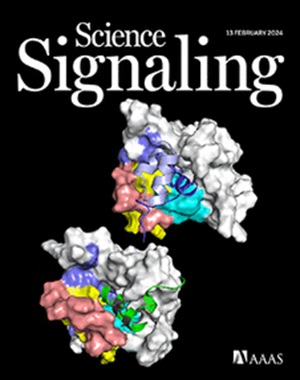The acetyltransferase GCN5 contributes to neuroinflammation in mice by acetylating and activating the NF-κB subunit p65 in microglia
IF 6.6
1区 生物学
Q1 BIOCHEMISTRY & MOLECULAR BIOLOGY
Science Signaling
Pub Date : 2025-03-04
引用次数: 0
Abstract
Neuroinflammation promotes the progression of various neurological and neurodegenerative diseases. Disrupted homeostasis of protein acetylation is implicated in neurodegeneration, and the lysine acetyltransferase GCN5 (also known as KAT2A) is implicated in peripheral inflammation. Here, we investigated whether GCN5 plays a role in neuroinflammation in the brain. Systemic administration of the bacterial molecule LPS in mice to induce peripheral inflammation increased the abundance of GCN5 in various organs, including in the brain and specifically in microglia. In response to LPS, GCN5 mediated the induction of the proinflammatory cytokines TNF-α and IL-6 and the inflammatory mediators COX-2 and iNOS in microglia. Further investigation in cultured microglial cells revealed that GCN5 was activated downstream of the innate immune receptor TLR4 to acetylate Lys310 in the NF-κB subunit p65, thereby enabling the nuclear translocation and transcriptional activity of NF-κB and the resulting inflammatory response. Thus, targeting GCN5 might be explored further as a strategy to reduce neuroinflammation in the treatment of associated diseases.
乙酰转移酶GCN5通过乙酰化和激活小胶质细胞中NF-κB亚基p65参与小鼠神经炎症
神经炎症促进各种神经和神经退行性疾病的进展。蛋白质乙酰化的稳态破坏与神经退行性变有关,赖氨酸乙酰转移酶GCN5(也称为KAT2A)与外周炎症有关。在这里,我们研究了GCN5是否在大脑的神经炎症中发挥作用。在小鼠体内系统给药细菌分子LPS诱导外周炎症增加了GCN5在各种器官中的丰度,包括在大脑中,特别是在小胶质细胞中。在LPS的作用下,GCN5介导了小胶质细胞中促炎细胞因子TNF-α和IL-6以及炎症介质COX-2和iNOS的诱导。在培养的小胶质细胞中进一步研究发现,GCN5在先天免疫受体TLR4下游被激活,使NF-κB亚基p65中的Lys310乙酰化,从而使NF-κB的核易位和转录活性以及由此产生的炎症反应成为可能。因此,靶向GCN5可能会进一步探索作为一种减少神经炎症治疗相关疾病的策略。
本文章由计算机程序翻译,如有差异,请以英文原文为准。
求助全文
约1分钟内获得全文
求助全文
来源期刊

Science Signaling
BIOCHEMISTRY & MOLECULAR BIOLOGY-CELL BIOLOGY
CiteScore
9.50
自引率
0.00%
发文量
148
审稿时长
3-8 weeks
期刊介绍:
"Science Signaling" is a reputable, peer-reviewed journal dedicated to the exploration of cell communication mechanisms, offering a comprehensive view of the intricate processes that govern cellular regulation. This journal, published weekly online by the American Association for the Advancement of Science (AAAS), is a go-to resource for the latest research in cell signaling and its various facets.
The journal's scope encompasses a broad range of topics, including the study of signaling networks, synthetic biology, systems biology, and the application of these findings in drug discovery. It also delves into the computational and modeling aspects of regulatory pathways, providing insights into how cells communicate and respond to their environment.
In addition to publishing full-length articles that report on groundbreaking research, "Science Signaling" also features reviews that synthesize current knowledge in the field, focus articles that highlight specific areas of interest, and editor-written highlights that draw attention to particularly significant studies. This mix of content ensures that the journal serves as a valuable resource for both researchers and professionals looking to stay abreast of the latest advancements in cell communication science.
 求助内容:
求助内容: 应助结果提醒方式:
应助结果提醒方式:


